What's New
Displaying results 2591 - 2600 of 4052
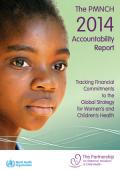
Resource | Publications,
This report reviews the progress made in implementing the financial commitments to the Global Strategy for Women’s and Children’s Health (Global Strategy). The strategy was launched by the United Nations Secretary- General (UNSG) Ban Ki-moon in September 2010 with the aim of saving 16 million lives in the world’s 49 poorest countries by 2015.
With the target date of the Millennium Development Goals (MDGs) in sight, the Global Strategy represents the most significant global effort to accelerate progress towards the health-related MDGs: MDG 4 (child survival), MDG 5 (maternal and reproductive health), MDG 6 (HIV, TB, and malaria), and MDG 1c (hunger). The Global Strategy identified six key areas in need of urgent action to improve women’s and children’s health. The Every Woman Every Child (EWEC) effort was established at the same time to advance the Global Strategy and to mobilize and intensify global action to improve reproductive, maternal, newborn, and child health (RMNCH).
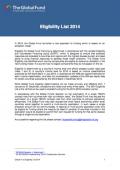
Resource | Data Sheets,
Eligibility for Global Fund financing is determined in accordance with the revised Eligibility and Counterpart Financing policy (ECFP), which is designed to ensure that available resources are allocated to countries and regions with the highest disease burden and least ability to bring financial resources to address these health problems. The Global Fund Eligibility List identifies which country components are eligible to receive an allocation in the new funding model. If a country has no eligible components they do not appear on the list.
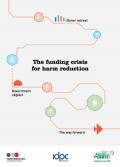
Resource | Publications,
Funding for HIV-related harm reduction programmes globally is in crisis. There can be no ‘AIDS free generation’ without targeted efforts with and for people who inject drugs, yet, as this report shows, funding for harm reduction falls dangerously short of estimated need. As a result, coverage of essential HIV and harm reduction programmes targeting people who inject drugs is very low and wholly inadequate to respond effectively to HIV among this community. While this has been the case for some time, the data and policy analysis conducted for this report shows that rather than action being taken to address this problem, the situation looks set to deteriorate.
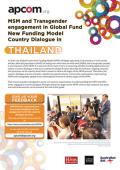
Resource | Publications,
In 2014, the Global Fund’s New Funding Model (NFM) will begin operating. Inclusiveness of civil society and key affected populations (KAP) (including men who have sex with men (MSM) and transgender people) is a key feature of the NFM. It is also one of the main criteria in assessing whether funding applications are robust. Country Dialogue is the term used by the Global Fund to describe the inclusive, ongoing consultative processes at the country level that is meant to inform all stages of the NFM process. Therefore, the country dialogue process presents a significant opportunity for civil society organisations representing MSM and transgender people to be meaningfully involved in all the stages of the NFM.
This resource guide is designed to assist civil society organisations in understanding the NFM and effectively engaging in country dialogue through all the key stages of the NFM.
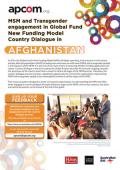
Resource | Publications,
In 2014, the Global Fund’s New Funding Model (NFM) will begin operating. Inclusiveness of civil society and key affected populations (KAP) (including men who have sex with men (MSM) and transgender people) is a key feature of the NFM. It is also one of the main criteria in assessing whether funding applications are robust. Country Dialogue is the term used by the Global Fund to describe the inclusive, ongoing consultative processes at the country level that is meant to inform all stages of the NFM process. Therefore, the country dialogue process presents a significant opportunity for civil society organisations representing MSM and transgender people to be meaningfully involved in all the stages of the NFM.
This resource guide is designed to assist civil society organisations in understanding the NFM and effectively engaging in country dialogue through all the key stages of the NFM.
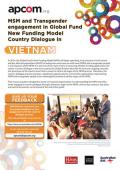
Resource | Publications,
In 2014, the Global Fund’s New Funding Model (NFM) will begin operating. Inclusiveness of civil society and key affected populations (KAP) (including men who have sex with men (MSM) and transgender people) is a key feature of the NFM. It is also one of the main criteria in assessing whether funding applications are robust. Country Dialogue is the term used by the Global Fund to describe the inclusive, ongoing consultative processes at the country level that is meant to inform all stages of the NFM process. Therefore, the country dialogue process presents a significant opportunity for civil society organisations representing MSM and transgender people to be meaningfully involved in all the stages of the NFM.
This resource guide is designed to assist civil society organisations in understanding the NFM and effectively engaging in country dialogue through all the key stages of the NFM.
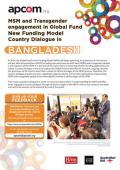
Resource | Publications,
In 2014, the Global Fund’s New Funding Model (NFM) will begin operating. Inclusiveness of civil society and key affected populations (KAP) (including men who have sex with men (MSM) and transgender people) is a key feature of the NFM. It is also one of the main criteria in assessing whether funding applications are robust. Country Dialogue is the term used by the Global Fund to describe the inclusive, ongoing consultative processes at the country level that is meant to inform all stages of the NFM process. Therefore, the country dialogue process presents a significant opportunity for civil society organisations representing MSM and transgender people to be meaningfully involved in all the stages of the NFM.
This resource guide is designed to assist civil society organisations in understanding the NFM and effectively engaging in country dialogue through all the key stages of the NFM.
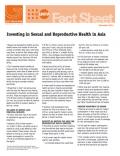
Resource | Fact Sheets,
Sexual and reproductive health services enable women and couples to have the number of children they want, when they want them; to deliver their babies safely and have healthy newborns; and to have healthy sexual lives, free from HIV and other sexually transmitted infections (STIs).
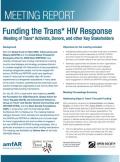
Resource | Publications,
Objectives for the meeting included:
- Highlighting existing data on the state of the trans* movement and the level of current investments by GFATM, PEPFAR, and other funders for HIV-focused trans* service delivery, advocacy, and research efforts at the local and national levels.
- Identifying opportunities and barriers for trans* organizations and communities participation in the country dialogue process of GFATM’s and PEPFAR’s country operational plans Strategizing about short-term and medium-term concrete actions that trans* activists, GFATM and PEPFAR representatives, and other stakeholders can take to increase trans* engagement in GFATM and PEPFAR funding processes.
- Establishing mechanisms for ongoing dialogue between trans* activists and representatives from GFATM and PEPFAR.
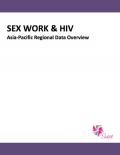
Resource | Data Sheets,
This Regional Data Overview presents regional data on sex work that is available as it pertains to HIV epidemiology, risk behaviours and vulnerability factors.
Commercial sex is the primary mode of HIV transmission in many Asian countries: where more people engage in commercial sex than in any other high-risk behaviour. An estimated 0.5%-15% of men pay for sex across the region. These men are one of the key determinants in both the spread and magnitude of HIV epidemics in the region, since they are the biggest single group that transmits HIV to their intimate partners.





